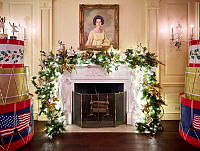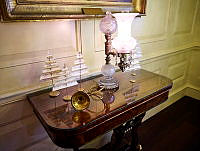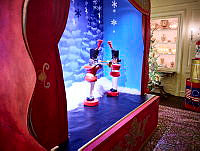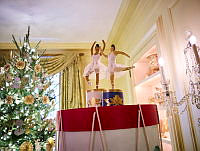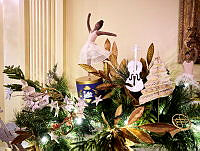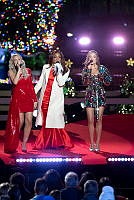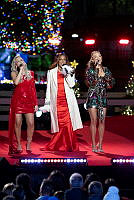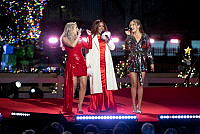Rubenstein Center Scholarship
A Friendly Voice
Marian Anderson and White House History

Marian Anderson singing at the Easter Sunday Concert at the Lincoln Memorial for over 75,000 attendees in April 1939.
National Archives and Records AdministrationMarian Anderson was a successful American contralto singer known for her enchanting performances in the United States and throughout the world. But it was her 1939 Easter concert at the Lincoln Memorial that brought her national attention and fame. Charmed by her voice and personality, First Lady Eleanor Roosevelt cultivated a relationship between the White House and Marian that would last for the rest of her musical career.
Anderson first performed at the White House in 1936. She was finishing her American tour in Washington, D.C., at the time, appearing at the nearby Armstrong Auditorium. Roosevelt invited her to entertain a dinner party the next evening for Circuit Court of Appeals Judge William Denman and his wife Leslie Van Ness.1 The performance captivated the attendees and especially Eleanor, who would continue to invite Marian to the White House.
Marian also sang at an annual benefit concert for Howard University, a local historically black university. Due to mounting public interest, the university needed to find a venue that could accommodate larger crowds. The best option was Constitution Hall, owned by the Daughters of the American Revolution (DAR). Like many other concert halls, restaurants, and businesses at the time, the DAR imposed rules of segregation on artists and attendees. They only permitted white artists to perform at Constitution Hall, and so the DAR denied Anderson the right to appear at their auditorium.

Marian Anderson with Reverend George W. Anthony, Director Newton Drury of the National Park Service, and Eleanor Roosevelt at the dedication of Franklin D. Roosevelt’s home at Hyde Park, New York as a national shrine on April 12, 1946.
Harry S. Truman Presidential Library and Museum/NARAFirst Lady Eleanor Roosevelt disapproved of this treatment of Anderson. The DAR had granted Eleanor membership after her husband, Franklin D. Roosevelt, was elected president in 1932; but in protest at the prohibition against Anderson the first lady resigned from the organization in 1939. She wrote in her column, My Day, “The question is, if you belong to an organization and disapprove of an action which is typical of a policy, should you resign or is it better to work for a changed point of view within the organization?”2 Instead of opting for the latter, Eleanor explained that her resignation was a rejection of segregation and organizations that endorse racial division. “They have taken an action which has been widely talked of in the press. To remain as a member implies approval of that action, and therefore I am resigning.”3
President Franklin D. Roosevelt and First Lady Eleanor Roosevelt intervened on Marian’s behalf, helping secure the Lincoln Memorial as the stage for her benefit concert. With over 75,000 citizens looking on, Anderson’s powerful voice inspired the crowds and brought massive applause. Later in her autobiography, Anderson wrote, “I cannot forget that demonstration of public emotion or my own strong feelings.”4
Eleanor Roosevelt continued to support Marian throughout her tenure as first lady. Eleanor extended many invitations to Anderson to perform at the White House, including the opportunity to sing for Queen Elizabeth and King George VI in June 1939.5 Anderson stated she was “one of those honored with an invitation to perform for the royal guests.”6 She sang her famous rendition of “Ave Maria,” as well as “My Soul’s Been Anchored in the Lord,” and “Tramping.”7
Roosevelt and Anderson had a special bond that extended beyond the White House. Roosevelt awarded Anderson the Spingarn Medal at the 30th Annual National Association for the Advancement of Colored People (NAACP) Conference.8 In her autobiography, Anderson mentioned leaving Roosevelt a message with soap on a mirror in a hall overseas when she found out Roosevelt was staying there after her.9 Eleanor met with Marian many times outside of the White House, including at Hyde Park, Tokyo, and Tel Aviv.10 The relationship between Anderson and the Roosevelts helped shape how future administrations collaborated with Anderson and recognized her talents.

Former First Lady Eleanor Roosevelt greeting Marian Anderson at a performance in Tokyo, Japan on May 22, 1953.
Franklin D. Roosevelt Presidential Library and Museum/NARAAnderson’s popularity with the presidents and first ladies continued to blossom throughout her career. Anderson was asked to perform the national anthem at President Dwight D. Eisenhower’s second inauguration.11 Anderson sang multiple times for President Eisenhower and his guests at the White House.12 Anderson also performed at President John F. Kennedy’s inauguration in 1961, where she again sang the national anthem for the crowds.13 Anderson was invited to sing in March 1962 at an event hosted in her honor. Titled, “An Evening with Marian Anderson,” the concert was held in the State Department auditorium.14 President Lyndon B. Johnson later awarded her the Presidential Medal of Freedom after President Kennedy’s death in December 1963.15 Anderson also performed at President Johnson’s event, “Festival of the Arts,” on June 14, 1965.16 Later, President Jimmy Carter awarded Anderson the Congressional Gold Medal, the first time it was given to an African American honoree.17
White House historian Elise Kirk noted, “Eleanor Roosevelt’s invitations to several black opera singers to perform in the White House were unprecedented in the 20th century.”18 Eleanor Roosevelt’s admiration for Anderson, and her decision to side with the African American performer, helped propel Marian’s musical career during a moment of social unrest. Anderson continued to return to the White House to perform for the presidents and their guests throughout her career. While her musical performances were certainly legendary, her story represents how American society, including the occupants of the White House, were forced to confront the prevailing racial prejudice of the times. By supporting Marian Anderson, First Lady Eleanor Roosevelt made an important statement regarding equality and tolerance, one that would not only influence future first ladies but also conversations and policies on integration.

On January 21, 1957, Chief Justice Earl Warren administrated the oath of office to Dwight D. Eisenhower on the east portico of the U.S. Capitol. Marian Anderson, bottom right corner in the white hat, performed at the inauguration.
Architect of the Capitol photo courtesy of the Library of Congress























